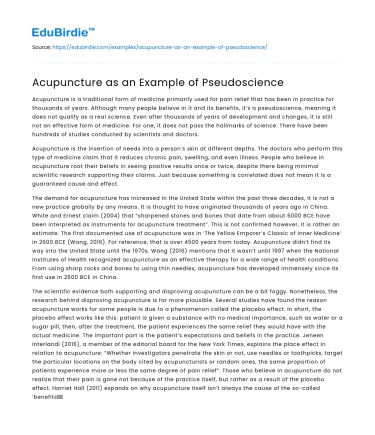Acupuncture is a traditional form of medicine primarily used for pain relief that has been in practice for thousands of years. Although many people believe in it and its benefits, it’s a pseudoscience, meaning it does not qualify as a real science. Even after thousands of years of development and changes, it is still not an effective form of medicine. For one, it does not pass the hallmarks of science. There have been hundreds of studies conducted by scientists and doctors.
Acupuncture is the insertion of needs into a person’s skin at different depths. The doctors who perform this type of medicine claim that it reduces chronic pain, swelling, and even illness. People who believe in acupuncture root their beliefs in seeing positive results once or twice, despite there being minimal scientific research supporting their claims. Just because something is correlated does not mean it is a guaranteed cause and effect.
Save your time!
We can take care of your essay
- Proper editing and formatting
- Free revision, title page, and bibliography
- Flexible prices and money-back guarantee
The demand for acupuncture has increased in the United State within the past three decades, it is not a new practice globally by any means. It is thought to have originated thousands of years ago in China. White and Ernest claim (2004) that “sharpened stones and bones that date from about 6000 BCE have been interpreted as instruments for acupuncture treatment”. This is not confirmed however, it is rather an estimate. The first documented use of acupuncture was in ‘The Yellow Emporer’s Classic of Inner Medicine’ in 2600 BCE (Wang, 2016). For reference, that is over 4500 years from today. Acupuncture didn’t find its way into the United State until the 1970s. Wang (2016) mentions that it wasn’t until 1997 when the National Institutes of Health recognized acupuncture as an effective therapy for a wide range of health conditions. From using sharp rocks and bones to using thin needles, acupuncture has developed immensely since its first use in 2600 BCE in China.
The scientific evidence both supporting and disproving acupuncture can be a bit foggy. Nonetheless, the research behind disproving acupuncture is far more plausible. Several studies have found the reason acupuncture works for some people is due to a phenomenon called the placebo effect. In short, the placebo effect works like this: patient is given a substance with no medical importance, such as water or a sugar pill, then, after the treatment, the patient experiences the same relief they would have with the actual medicine. The important part is the patient’s expectations and beliefs in the practice. Jeneen Interlandi (2016), a member of the editorial board for the New York Times, explains the place effect in relation to acupuncture: “Whether investigators penetrate the skin or not, use needles or toothpicks, target the particular locations on the body cited by acupuncturists or random ones, the same proportion of patients experience more or less the same degree of pain relief”. Those who believe in acupuncture do not realize that their pain is gone not because of the practice itself, but rather as a result of the placebo effect. Harriet Hall (2011) expands on why acupuncture itself isn’t always the cause of the so-called ‘benefits’. She mentions that “the nonspecific effects of treatment are likely responsible for any reported benefits”. Time and time again studies prove that acupuncture alone is never the sole reason pain has diminished. There are several factors that play a role in reducing someone’s pain, such as the amount of sleep they get, their diet, medications, exercise, etc.
I think it is extremely important to distinguish between pseudoscience and real science for several reasons. For one, today there are many people who go around spreading false ideals and beliefs. In addition, today’s world is built upon research. It is important to we spend our money on real scientific research that can benefit everyone, rather than pseudoscience like acupuncture, which only works due to the placebo effect. There are also economic consequences in relying on pseudoscience. For example, an average acupuncture session costs upwards to $70 per week, according to Lesley Alderman (2010), a writer for the New York Times. And that was nine years ago, I can only imagine the price has increased since then. In my opinion, it is not financially smart to spend that much money on something that is proven to not work the way believers say it does. I think it is smarter to spend your money on medicine practices that are guaranteed to work in the long term, even if it costs a little extra. In the medical field, evidence-based reasoning is important because it determines the best care for each individual. If we just continue follow pseudoscience blindly, it can cost us economically and physically.






 Stuck on your essay?
Stuck on your essay?

